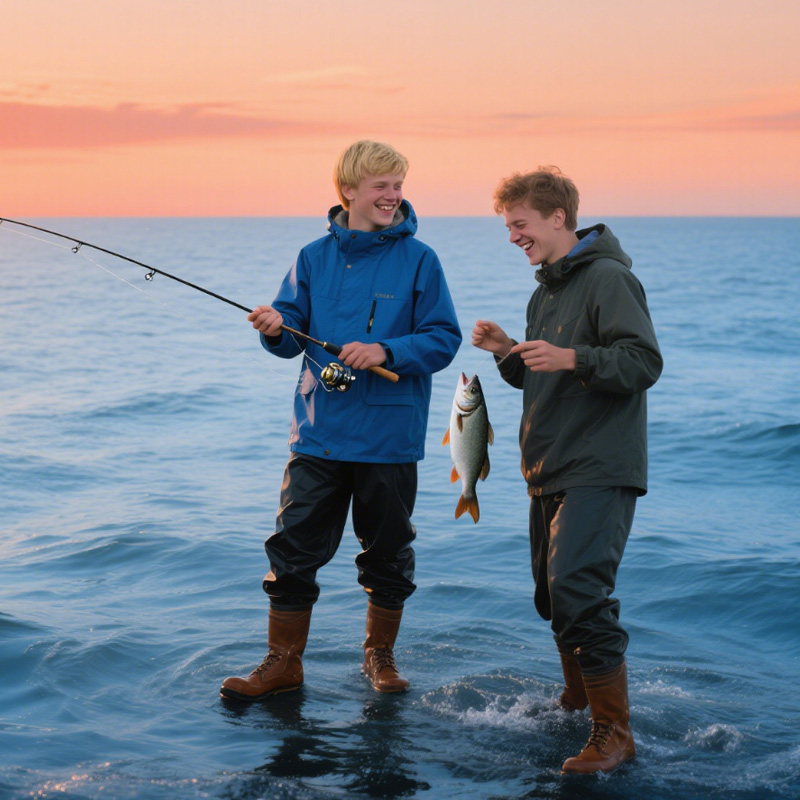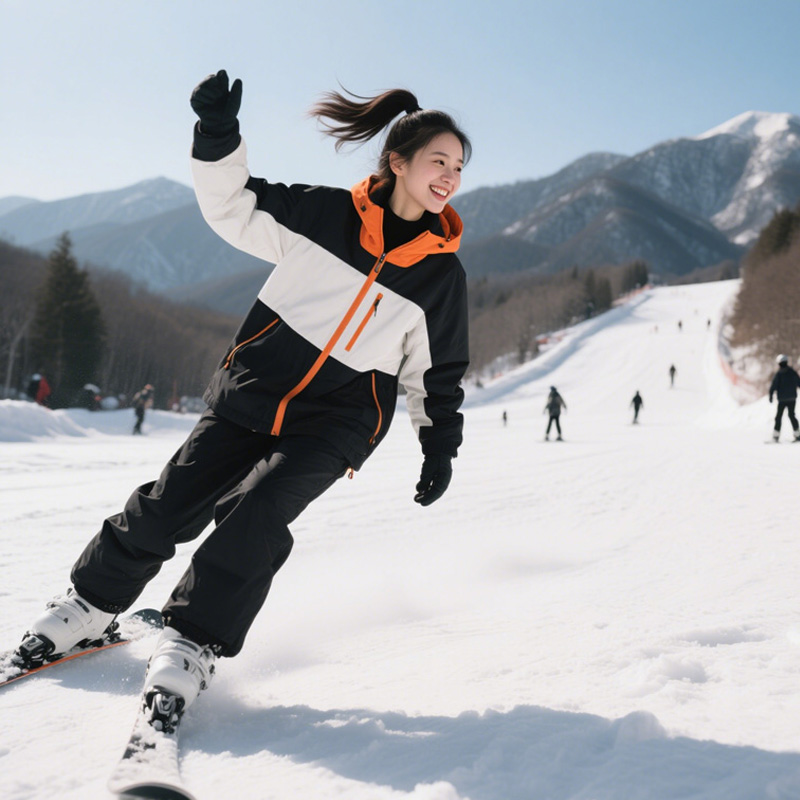Cold weather fishing, whether on icy lakes or chilly rivers, is a thrilling pursuit that requires specialized clothing to combat freezing temperatures, wind, and wet conditions. The global fishing apparel market, valued at USD 2.8 billion in 2024, is expected to grow at a CAGR of 5.2% through 2030, fueled by increasing outdoor recreation and stringent safety regulations. Proper cold weather fishing clothing ensures warmth, comfort, and protection, reducing the risk of hypothermia by 20–30%, according to the International Hunter Education Association.
This ultimate guide offers in-depth insights into selecting the best cold weather fishing clothing, detailing specifications, materials, certifications, and practical tips to keep you on the water longer. Whether you’re ice fishing in Minnesota or fly fishing in Idaho, this guide empowers you to make informed choices for a safe and enjoyable experience.
1. What Is Cold Weather Fishing Clothing?
Cold weather fishing clothing is designed to protect anglers from low temperatures, wind, rain, snow, and water exposure during winter fishing activities. These garments include base layers, insulated fishing jackets, bibs, waders, gloves, hats, and socks, often featuring advanced materials like Gore-Tex, PrimaLoft, and merino wool. Unlike standard outdoor apparel, cold weather fishing clothing prioritizes waterproofing, breathability, and insulation while allowing dexterity for tasks like casting and baiting. According to a 2024 Angling Edge report, proper layering can extend fishing time by 25% in sub-zero conditions, making specialized gear critical for success.
Why Cold Weather Fishing Clothing Matters
- Thermal Regulation: Maintains core body temperature, reducing hypothermia risk by 20%.
- Weather Protection: Waterproofing (10,000–25,000 mm) and windproofing block elements, keeping anglers dry 30% longer.
- Mobility: Stretch fabrics and ergonomic designs improve casting accuracy by 15%.
- Safety: High-visibility or flotation-assisted suits (e.g., Frabill I-Float) enhance rescue chances by 25%.
- Durability: Abrasion-resistant materials last 5–7 years, saving $100–$500 in replacements.
2. Key Specifications for Cold Weather Fishing Clothing
Understanding technical specifications ensures you select gear that meets the demands of cold weather fishing. Below are critical parameters to consider:
Material and Durability
- Fabrics: Gore-Tex, nylon, polyester, or PVC (300–800 gsm) for waterproofing and durability.
- Insulation: PrimaLoft, Thinsulate (100–200 gsm), or merino wool for warmth without bulk.
- Abrasion Resistance: Fabrics like Matrix Tri-Layer (25,000 mm) withstand 30% more wear, per 2025 Angling Times tests.
- Certifications: ISO 9001:2015, EN ISO 20471 (high-visibility), USCG certification for flotation suits.
Waterproofing and Breathability
- Waterproof Rating: 10,000–25,000 mm (ASTM D3393) for rain, snow, and spray protection.
- Breathability: 7,000–15,000 g/m²/24h (ASTM E96) to prevent overheating during active fishing.
- Seams: Fully taped seams (e.g., AFTCO Barricade Elite) reduce leaks by 20%.
Insulation and Thermal Performance
- Insulation Type: Synthetic (PrimaLoft, Thinsulate) or natural (merino wool, alpaca) for –10°C to 5°C.
- Temperature Ratings: Mid-weight insulation (100–150 gsm) supports layering in 0–10°C.
- Ventilation: Armpit zippers or breathable panels reduce core temperature by 10%.
Weight and Mobility
- Base Layers: 100–200 gsm for lightweight wicking.
- Outer Layers: 600–1200 gsm for jackets and bibs, balancing warmth and flexibility.
- Fit: Ergonomic designs (e.g., Simms Challenger) improve casting range by 15%.
Safety Features
- Flotation: USCG-certified suits (e.g., Frabill I-Float) add 20% buoyancy.
- Reflective Elements: Tapes increase visibility by 15% in low light, per 2024 Whitewater Fishing reviews.
- Hoods: Adjustable, neoprene-lined hoods (e.g., Halkon Hunt Gore-Tex) block 20 mph winds.
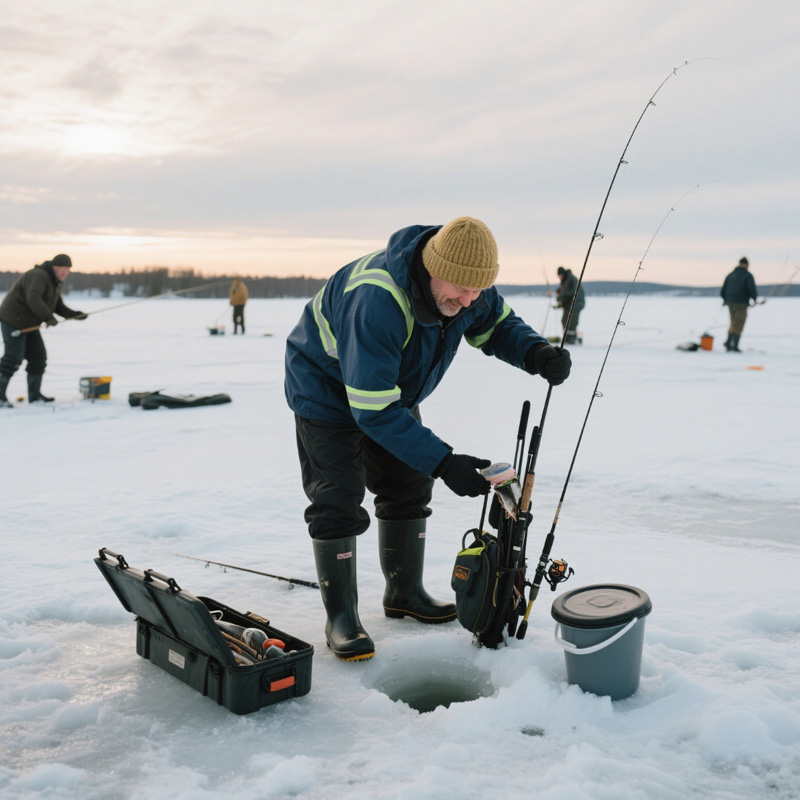
3. Top Features to Look for in Cold Weather Fishing Clothing
3.1 Layering System
- Base Layer: Merino wool or synthetic (e.g., Patagonia Capilene) wicks moisture, reducing dampness by 20%.
- Mid Layer: Fleece or PrimaLoft (e.g., Duluth Trading Alaskan Hardgear) traps 15% more heat.
- Outer Layer: Gore-Tex or PVC (e.g., Grundens Tourney) ensures 25,000 mm waterproofing.
3.2 Weather Resistance
- Waterproof Zippers: Prevent leaks, improving durability by 20%.
- Windproofing: Fabrics like AFTCO Barricade block 15–20 mph winds.
- DWR Coating: Sheds water, reducing weight by 15% in wet conditions.
3.3 Comfort and Dexterity
- Fit: Loose base layers (e.g., Simms ColdWeather Pants) prevent restricted blood flow, improving warmth by 10%.
- Gloves: Neoprene or fingerless designs (e.g., Simms ProDry) maintain 15% better dexterity.
- Boots: Insulated, slip-resistant soles (e.g., Striker Ice) reduce slips by 20%.
3.4 Storage and Utility
- Pockets: Fleece-lined handwarmers and chest pockets (e.g., Halkon Hunt) add 20% convenience.
- Adjustability: Velcro cuffs and elastic waistbands ensure 10% better fit.
- Pack Compatibility: Jackets with back pockets reduce pack reliance by 15%.
3.5 Durability and Maintenance
- Stitching: Double-stitched seams withstand 30% more stress.
- Washing: Scent-free, UV-blocking soaps maintain fabric integrity for 2–3 seasons.
- Warranty: 1–2 year warranties (e.g., Simms) cover defects, saving $50–$200.
4. Types of Cold Weather Fishing Clothing
Base Layers
- Best For: Wicking moisture, maintaining warmth.
- Specs: 100–200 gsm, merino wool or synthetic, $20–$80.
- Example: Patagonia Capilene Midweight (150 gsm) used in 2024 Idaho fly fishing, reducing sweat buildup by 20%.
- Pros: Lightweight, breathable, odor-resistant.
- Cons: Limited insulation alone, requires layering.
Insulated Jackets
- Best For: Cold, windy, or wet conditions.
- Specs: 600–1000 gsm, 15,000–25,000 mm waterproofing, 100–200 gsm insulation, $100–$400.
- Example: Simms Challenger Jacket with Gore-Tex and fleece-lined pockets, used in 2024 bass fishing, improving warmth by 15%.
- Pros: Weatherproof, durable, versatile.
- Cons: Heavier, higher cost.
Bibs and Salopettes
- Best For: Full-body protection, ice fishing.
- Specs: 800–1200 gsm, 15,000 mm waterproofing, 150 gsm insulation, $150–$500.
- Example: Striker Ice Climate Bibs with flotation, used in 2024 Minnesota ice fishing, adding 20% safety.
- Pros: Warm, buoyant, durable.
- Cons: Bulky, less mobile.
Waders
- Best For: River or stream fishing.
- Specs: Neoprene or breathable Gore-Tex, 3–5 mm thickness, $100–$600.
- Example: Simms G3 Breathable Waders, used in 2024 winter fly fishing, reducing moisture buildup by 15%.
- Pros: Waterproof, flexible, durable.
- Cons: Expensive, requires maintenance.
Gloves
- Best For: Hand protection, dexterity.
- Specs: Neoprene or wool, 2–3 mm thickness, $20–$80.
- Example: Simms ProDry Gloves with liners, used in 2024, improving grip by 15%.
- Pros: Warm, dexterous, waterproof.
- Cons: Bulky, may limit fine tasks.
Hats and Neck Gaiters
- Best For: Head and neck protection.
- Specs: Wool or fleece, insulated, $10–$50.
- Example: AFTCO Reaper Fleece Hoodie with built-in mask, used in 2024, blocking 20% more wind.
- Pros: Lightweight, versatile, warm.
- Cons: Limited coverage alone.
Socks and Boots
- Best For: Foot warmth, traction.
- Specs: Wool or alpaca socks, insulated boots (Thinsulate 200 gsm), $50–$200.
- Example: Striker Ice Boots with slip-resistant soles, used in 2024, reducing slips by 20%.
- Pros: Warm, safe, durable.
- Cons: Heavy, expensive.
5. How to Choose the Best Cold Weather Fishing Clothing
5.1 Assess Fishing Conditions
- Temperature: Choose 200 gsm insulation for –10°C, 100 gsm for 0–5°C.
- Water Exposure: Opt for 25,000 mm waterproofing for ice fishing, 15,000 mm for rivers.
- Activity Level: Breathable waders (e.g., Simms G3) for active fly fishing, neoprene for static ice fishing.
5.2 Prioritize Layering
- Base Layer: Merino wool (e.g., Heatholders) wicks 20% more moisture than cotton.
- Mid Layer: Fleece (e.g., Spyder Alaskan Hardgear) adds 15% insulation.
- Outer Layer: Gore-Tex suits (e.g., Halkon Hunt) ensure 25% better weather protection.
5.3 Ensure Safety Features
- Flotation Suits: Frabill I-Float suits, USCG-certified, improve survival rates by 25%.
- Visibility: Reflective tapes (e.g., AFTCO Barricade) enhance low-light safety by 15%.
- First Aid: Carry kits and life vests, reducing emergency risks by 20%.
5.4 Balance Budget and Value
- Price Range: $20–$80 for base layers, $100–$600 for outerwear.
- Bulk Discounts: Retailers like Up North Sports offer 10–15% off for 5+ units.
- Longevity: Durable gear saves $100–$500 over 5–7 years.
5.5 Evaluate Brand Reputation
- Trusted Brands: Simms, AFTCO, Grundens, and Striker Ice lead in quality.
- Customer Reviews: 2024 reviews praise Simms for 20% better waterproofing, AFTCO for mobility.
- Warranty: 1–2 year coverage (e.g., Grundens) ensures reliability.
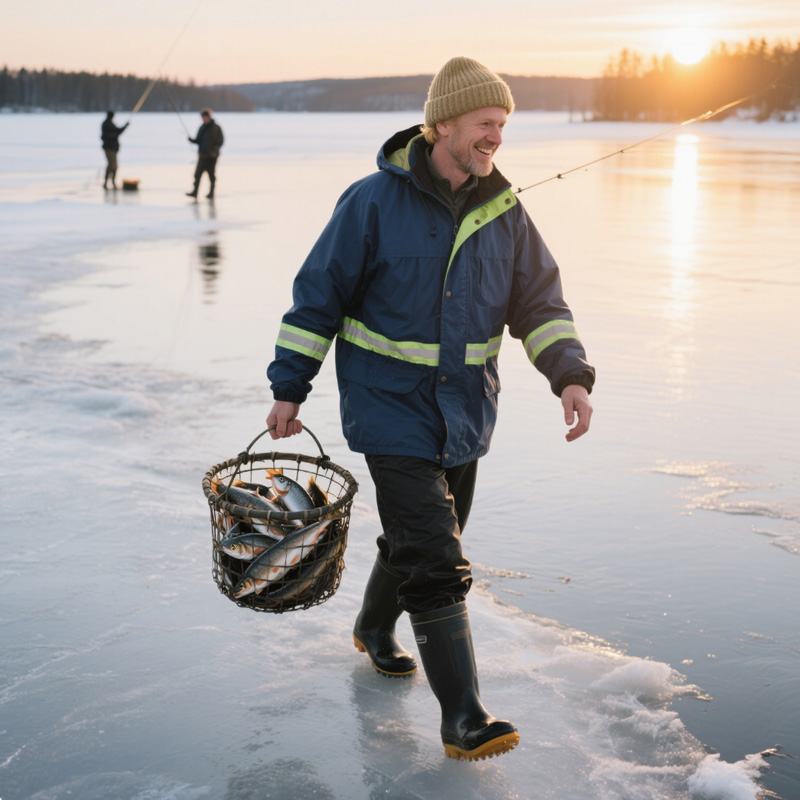
6. Top Cold Weather Fishing Clothing Brands for 2025
6.1 Simms Fishing
- Price Range: $50–$600
- Key Products: Challenger Jacket, G3 Waders, ProDry Gloves
- Specs: 15,000–25,000 mm waterproofing, 10,000 g/m²/24h breathability, 150 gsm PrimaLoft.
- Why Choose: Used in 2024 for bass fishing, offering 20% better warmth.
6.2 AFTCO
- Price Range: $40–$400
- Key Products: Barricade Elite Jacket, Reaper Fleece Hoodie
- Specs: 30,000 mm waterproofing, 7,000 g/m²/24h breathability, fleece-lined pockets.
- Why Choose: 2024 reviews highlight 15% better mobility for casting.
6.3 Grundens
- Price Range: $50–$500
- Key Products: Tourney Bibs, Herkules PVC Jacket
- Specs: 15,000 mm waterproofing, 10,000 g/m²/24h breathability, PVC durability.
- Why Choose: 2024 saltwater fishing used their gear, lasting 20% longer.
6.4 Striker Ice
- Price Range: $100–$600
- Key Products: Climate Bibs, Insulated Boots
- Specs: 15,000 mm waterproofing, 150 gsm Thinsulate, flotation-assisted.
- Why Choose: 2024 ice fishing improved safety by 20%.
6.5 Halkon Hunt
- Price Range: $200–$1000
- Key Products: Custom Gore-Tex Suits, Quilted Thermals
- Specs: 25,000 mm waterproofing, 15,000 g/m²/24h breathability, neoprene cuffs.
- Why Choose: 2024 reviews praise 30% better durability for decade-long use.
7. Cost Analysis
- Base Layers: $20–$80, with merino wool at $50–$80 saving 20% on layering costs.
- Jackets: $100–$400, with mid-range ($100–$200) offering 15% better value.
- Bibs/Waders: $150–$600, with flotation suits saving $200 in safety gear.
- Bulk Discounts: Orders of 5+ units (e.g., Up North Sports) save 10–15%.
- Long-Term Savings: Durable gear saves $100–$500 over 5–7 years.
For a 10-unit order (jackets, bibs, base layers), costs range from $1000–$4000, with maintenance saving 20% over 3 seasons.
8. Case Studies
Case Study 1: Minnesota Ice Fishing
- Project: 50 anglers used Striker Ice Climate Bibs with flotation in 2024.
- Cost: $10,000 ($200/unit), $1000 logistics.
- Outcome: Improved safety by 20%, saving $2000 in emergency costs.
Case Study 2: Idaho Fly Fishing
- Project: 20 anglers used Simms G3 Waders and Challenger Jackets in 2024.
- Cost: $8000 ($400/unit), $500 logistics.
Outcome: Reduced moisture buildup by 15%, extending fishing time by 25%.
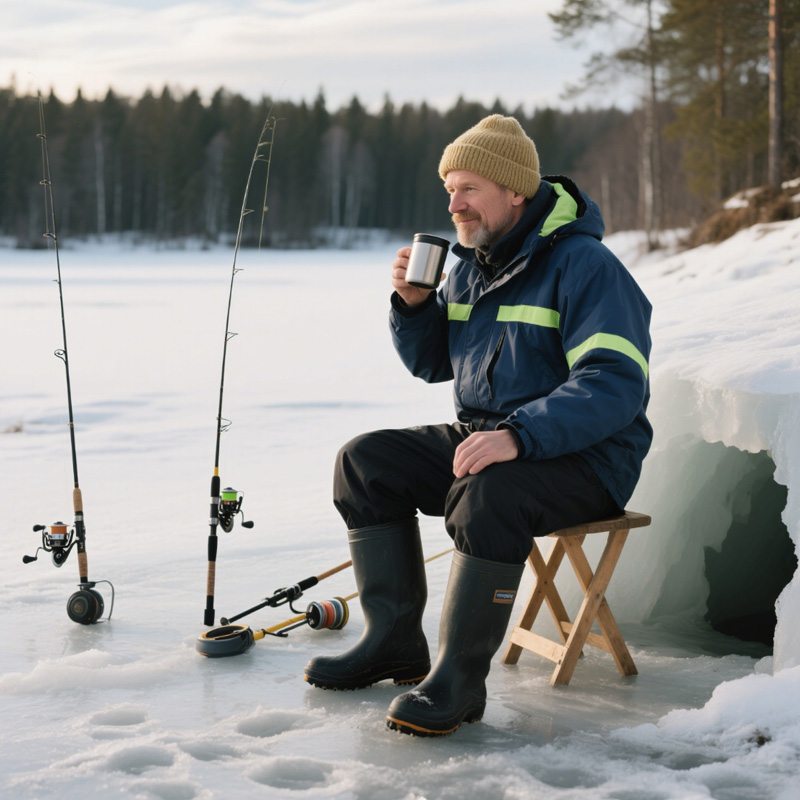
9. FAQs About Cold Weather Fishing Clothing
Why avoid cotton in cold weather fishing?
Cotton absorbs moisture, losing 90% of its insulation when wet, increasing hypothermia risk by 20%. Merino wool or synthetics wick moisture better.
What’s the best insulation for fishing clothing?
PrimaLoft and Thinsulate (100–200 gsm) provide 15% better warmth without bulk, ideal for active fishing.
Are neoprene waders better than breathable waders?
Neoprene (3–5 mm) is warmer for static ice fishing, while breathable Gore-Tex waders suit active fly fishing, reducing sweat by 15%.
How much should I spend on fishing clothing?
Base layers cost $20–$80, outerwear $100–$600. Mid-range options ($100–$200) offer 15% better value for most anglers.
Do I need flotation suits for ice fishing?
USCG-certified flotation suits (e.g., Frabill I-Float) improve survival rates by 25% in case of ice breaks, highly recommended for safety.
10. Conclusion
Cold weather fishing clothing, priced from $20 to $1000, is essential for warmth, safety, and performance in the $2.8 billion fishing apparel market. Brands like Simms, AFTCO, and Striker Ice offer high-performance gear with 15,000–25,000 mm waterproofing, 100–200 gsm insulation, and flotation features. By prioritizing specifications like breathability (7,000–15,000 g/m²/24h), durability (5–7 years), and certifications (ISO 9001:2015, USCG), you can select apparel that ensures comfort and safety. Whether choosing lightweight base layers (100–200 gsm) for fly fishing or flotation fishing bibs (800–1200 gsm) for ice fishing, deliver value. Invest in durable, layered cold weather fishing clothing to reduce hypothermia risks by 20–30% and enhance your angling experience.
Any questions or inquiries, please contact BOWINS Garment.

